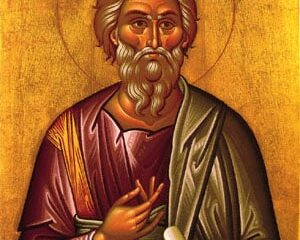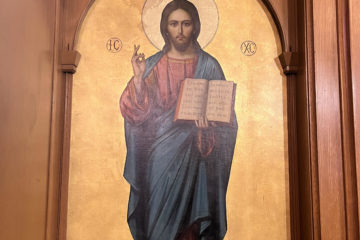Then Moses said to God, “If I come to the people of Israel and say to them, ‘The God of your faithers has sent me to you,’ and they ask me, ‘What is His name?’ what shall I say to them?” God said to Moses, “I AM who I AM.” And He said, “Say this to the people of Israel, ‘I AM has sent me to you.’”
Exodus 3:13-14
In the book of Genesis, we read about the Creation of the world by the Holy Trinity, the creation of mankind in the image and likeness of God, and the fall of mankind through the deception of the serpent. God’s plan for the redemption of humanity begins to take shape with a covenant He makes with Abraham. A line of genealogy continues with Abraham’s son, Isaac, and Isaac’s son, Jacob, and this line will eventually lead, forty-two generations later, to the Christ. Jacob (whose name is later changed by God to “Israel”) has twelve sons, and the twelve tribes of Israel bear their names. Jacob’s favorite son, Joseph, is sold into slavery in Egypt, but God uses this for the good, as Joseph saves the world from famine. Eventually, all of Joseph’s family relocates to Egypt, and after all of Joseph’s family has passed on, and the Pharaoh of Egypt who honored Joseph and his family passes on, a new Pharaoh comes into power and enslaves the children of Israel for many generations. It seems that all hope is lost, as the people toil away under the oppressive rule of the Egyptians.
Moses is a Hebrew (child of Israel, Jewish, the names are all interchangeable) born at a time when Pharaoh is in fear of the Hebrews and orders that boys be killed for fear that they will one day rise up against the Egyptians. The mother of Moses puts him into a basket and places him in the river, and later the daughter of Pharaoh finds the basket and spares Moses, raising him in the palace of Pharaoh. In his young adult life, Moses, sees an Egyptian beating a Hebrew and he kills the Egyptian, but then flees to Midian out of fear. There he becomes a shepherd, gets married and lives a quiet, anonymous life. Moses also has a stutter when he speaks.
One day, while tending the sheep. Moses encounters a bush that is burning, but not consumed by the fire. God calls out to Moses from the burning bush. It must be an amazing thing to hear the voice of God calling, and calling out of a bush nonetheless. Moses answers, with words of submission heard by others that God is calling: “Here am I.” (Exodus 3:4) God responds that Moses is to remove the shoes from his feet, as he is standing on holy ground. God them reveals Himself as the God of Abraham, Isaac and Jacob. In other words, the voice Moses is hearing is the voice of the one True God. Again, this is amazing, as the voice of God has been perceived as silent, as the children of Israel suffer generations of slavery at the hands of the Egyptians.
God assures Moses that He has seen and heart the sufferings of His people and that God’s plan is to deliver them from the bondage of Pharaoh and return them to the land of Canaan, which God has long ago given to Abraham. God anoints Moses, the anonymous, improbable and stuttering shepherd to lead the people out of Egypt. Moses, who had answered God with an obedient “Here am I” understandably expresses doubt in God’s assignment, saying to God, “Who am I that I should go to Pharaoh, and bring the sons of Israel out of Egypt?” Many people will express the same doubt to God, as He calls many to His service. This same doubt is expressed by lots of devout Christians, even Christian leaders, to this day. God reassures Moses that He will be with Moses. Moses then asks God “If I come to the people of Israel and say to them, ‘The God of your faithers has sent me to you,’ and they ask me, ‘What is His name? what shall I say to them?” (Exodus 3:13) In other words, by whose authority is Moses speaking to the people?
And God answers “I am who I am.” (Exodus 3:14) And THIS is the Divine Name of God. In Hebrew, the name is one word, “Yahweh”. In English, it is “I AM,” and in Greek it is “O ON,” which is translated as “He Who Is.” “I AM” is the divine name of God, first revealed to Moses through the burning bush.
In the New Testament, there would be seven times in the Gospels, plus two in the book of Revelation, that Jesus speaks with the Divine Name of God. In all icons of Christ, in His halo, the Greek letters O ON (O WN), which reveal the name of God in the person of Jesus Christ, the Word of God made flesh. This is one of the ways to distinguish His icon from all others—only the icon of Christ has letters in the halo.
One other interesting fact about the encounter of Moses at the burning bush is that the burning bush prefigures both the Virgin Mary and the sacrament of Holy Communion. The Virgin Mary touched the fire of God (Therefore let us be grateful for receiving a kingdom that cannot be shaken, and thus let us offer to God acceptable worship, with reverence and awe; for our God is a consuming fire. Hebrews 12:28-29) by carrying Christ in her womb and was not eviscerated because of the experience. Through Holy Communion, we also touch the fire of God and we are not consumed, burned or harmed.
The Mighty One, God the Lord, speaks and summons the earth from the rising of the sun to its setting. Out of Zion, the perfection of beauty, God shines forth. Our God comes, He does not keep silence, before Him is a devouring fire, round about Him a mighty temptest. He calls to the heavens above and to the earth, that He may judge His people: “Gather to Me My faithful ones, who made a covenant with Me by sacrifice!” The heavens declare His righteousness, for God Himself is judge! Psalm 50:1-6
After the encounter with the burning bush, “I AM” was universally accepted as the name for God. This sets the stage for the New Testament, for Jesus using the “I AM” statements in a way that identified Him as the Son of God.



0 Comments